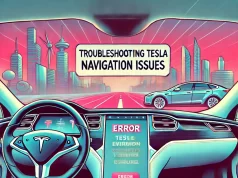Tesla claims that FSD is a “step change” in the evolution of autonomous driving and that it will eventually enable fully autonomous driving without human intervention.
In this article, we will explore some of the possible causes and solutions for Tesla FSD not working properly.
Why Tesla FSD Not Working?
There are many factors that can affect the performance and functionality of FSD on Tesla vehicles. Some of the possible causes are:
#1. Software Bug
FSD is still in development and testing phase, and it is not a finished product. Therefore, it may contain bugs or glitches that can cause errors or malfunctions in the system.
For example, some Tesla owners reported that the FSD stopped working after updating to software version 2022.20.18 or that the FSD did not activate after purchasing the subscription.
Tesla may also pause the rollout of the FSD due to safety recalls or regulatory issues.
#2. Camera & Sensor Issues
FSD relies on a combination of sensors, cameras, radar, and computer hardware to process and interpret the surrounding environment and execute driving actions.
However, these hardware components may have limitations in terms of accuracy, resolution, range, or reliability.
For example, some Tesla owners reported that FSD did not work well in low-light conditions or when the cabin camera was obstructed.
Additionally, some older Tesla models may not have the necessary hardware upgrades to support FSD.
#3. Environmental Causes
FSD is designed to work in a variety of road and weather conditions, but it may not be able to handle every possible situation.
For example, some Tesla owners reported that FSD struggled with snow, rain, fog, sun glare, or poor road quality.
Moreover, FSD may not be able to cope with dynamic or unpredictable scenarios such as emergency vehicles, animals, debris, or human behavior.
#4. Other Reasons
FSD is not intended to replace human drivers, but rather to assist them in driving tasks.
Therefore, human factors such as attention, awareness, judgment, and intervention are still crucial for the safety and effectiveness of FSD.
For example, some Tesla owners reported that FSD made mistakes or errors that required human correction or override.
Furthermore, human drivers may have different expectations, preferences, or habits that may conflict with FSD beta’s logic or behavior.
How to Fix Tesla FSD Not Working Error?
There are several steps that Tesla owners can take to troubleshoot or resolve issues with FSD not working properly on their vehicles. Some of the possible solutions are:
#1. Check For Software Updates
Tesla regularly releases software updates for its vehicles that may contain bug fixes, improvements, or new features for FSD.
Therefore, it is important to check if there are any pending software updates for your vehicle and install them as soon as possible.
You can check for software updates by going to the menu > Software > Check for Updates on your vehicle’s touchscreen.
You may need to connect your vehicle to a Wi-Fi network to download software updates.
#2. Calibrate Cameras
It is also important to check if your vehicle’s hardware components are functioning properly and are not damaged or obstructed.
You can check the status of your vehicle’s sensors and cameras by going to the menu > Service > Quick Controls > Adjustments > Camera Calibration on your vehicle’s touchscreen.
You may need to clean or replace your vehicle’s sensors and cameras if they are dirty, foggy, cracked, or misaligned. You may also need to upgrade your vehicle’s hardware if it is incompatible with FSD.
#3. Adjust Speed, Distance & Route
It is also important to be aware of the environmental conditions that may affect the performance and functionality of FSD on your vehicle.
You may need to adjust your driving speed, distance, or route according to the road and weather conditions.
You may also need to avoid driving in situations that are too complex or dynamic for FSD to handle.
You can check the limitations and warnings of FSD beta by going to the menu > Autopilot > Full Self-Driving Capability on your vehicle’s touchscreen.
#4. Be Careful
It is also important to be attentive, alert, and responsible when using FSD on your vehicle. You should always keep your hands on the steering wheel and your eyes on the road when FSD is engaged.
You should also be ready to take over control of your vehicle at any time if FSD makes a mistake or encounters a problem. You should also follow the traffic laws and rules of the road when using FSD.
You can check the terms and conditions of FSD by going to the menu > Autopilot > Full Self-Driving Capability > Terms and Conditions on your vehicle’s touchscreen.
Conclusion
Tesla’s FSD is a promising and innovative software package that aims to enable autonomous driving functions on Tesla vehicles. However, FSD is not perfect and may not work properly in some cases.
There are many possible causes and solutions for FSD not working, and Tesla owners should be aware of them and take appropriate actions to ensure the safety and effectiveness of FSD.
FSD is still in the development and testing phase, and Tesla may improve or update it in the future.




